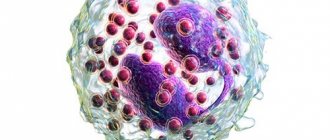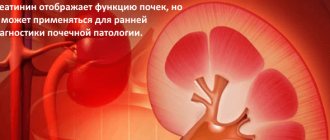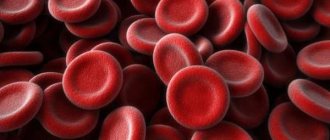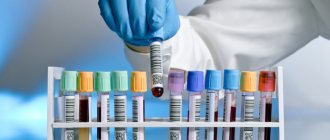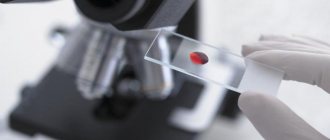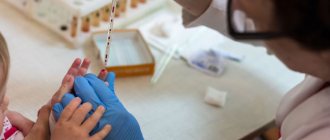17112 10 August
IMPORTANT!
The information in this section cannot be used for self-diagnosis and self-treatment.
In case of pain or other exacerbation of the disease, diagnostic tests should be prescribed only by the attending physician. To make a diagnosis and properly prescribe treatment, you should contact your doctor. We remind you that independent interpretation of the results is unacceptable; the information below is for reference only.
Clinical blood test: indications for use, rules for preparing for the test, interpretation of results and normal indicators.
Carrying out analysis
Like many other diagnostic examinations, for clinical analysis you need to come to the clinic on an empty stomach in the morning. As a response, the woman receives a table with a breakdown of the general laboratory blood test. This form is prepared within a few hours and then handed over to the attending physician or to the patient.
Red blood cells
The UAC considers the following parameters:
- Amount of hemoglobin;
- Red blood cell content;
- Blood color index;
- Reticulocyte count;
- Platelet level;
- Creatinine;
- ESR (ROE);
- Leukocytes, presented in the form of a leukocyte formula.
Let's take a closer look at each characteristic.
How to prepare for research
The most important recommendation before taking the test is to avoid eating late. Under no circumstances should you fast before the KLA. Meals should be normal. Limiting certain foods during the day will not affect the results in any way.
But after 8 o'clock. There is no need to eat in the evening. Lipid particles called chylomicrons can significantly distort the test results. There is also no need to have breakfast before the KLA. This can cause nutritionally-related leukocytosis, which will also confuse the attending physician.
The drinking regime remains the same. It is advisable not to limit yourself in fluid intake, as this fact will contribute to blood thickening or hemoconcentration. Drinking alcoholic beverages on the eve of the study is strictly prohibited. After all, ethyl alcohol can affect any of the UAC indicators.
Psycho-emotional factors, including stress, distort the results. This is reflected in changes in the number of leukocytes and erythrocyte sedimentation rate. This is also worth taking into account. Therefore, before taking the UAC, it is better to calm down and not think about anything. It is advisable not to smoke cigarettes at least half an hour before the planned blood draw.
If a child donates blood, the mother should reassure him. After all, crying and screaming are additional factors that lead to thickening of the blood and an increase in the number of leukocytes or white blood cells.
You should discuss taking medications with your doctor. As a rule, they do not dramatically affect the results of a general blood test. Therefore, in some situations, medications may be taken before the OAC study.
Complete blood count: normal for women by age table
One of the main indicators of a clinical study is the level of red blood cells. We are talking about red blood cells, which make up the largest group of blood cells. These particles ensure the transport of oxygen throughout the body.
Red blood cells contain a protein, hemoglobin, to which oxygen “sticks.” If the value of this indicator in a woman is higher or lower than normal, then we can judge the presence of pathology: anemia, weakened immunity, or a recent infection.
However, the causes of deviations can be more dangerous. If the amount of hemoglobin in the analysis is too low, then it is worth undergoing additional examination. And elevated values are much less common; they mainly indicate hematological pathologies or dehydration.
Norms of general blood test in women - table
If the study showed that the rate of red blood cells itself is too high, then this may confirm lung disease, stress, or heart disease.
Standard for adults:
- The standards for red blood cells in patients of both sexes are the same - 4.2-5.3 million per 1 μl;
- The standards for hemoglobin are different; for women they are 119-141 g/l;
- Normal hemoglobin for males is 130-161 g/l.
The difference is due to the fact that during menstruation or pregnancy in women, the hemoglobin content decreases. At a young and mature age, the values of the norm may also differ.
If the level of red blood cells is low, this may indicate a lack of vitamin B12 in the woman’s body or the presence of bleeding. During menstruation, there is a physiological drop in the level of red blood cells - this is not considered a pathology.
A physiologically elevated level of these cells is found in people living in the mountains - for them this is the norm. To clarify the diagnosis, you may need to take other tests.
If red blood cells increase, this may indicate that the patient has problems with the respiratory system, blood formation, or heart.
When is a test ordered?
As part of preventive examinations and medical examinations, a general blood test is an integral procedure. At the same time, it is a kind of screening method for diagnosing a major group of diseases. That is, it is so universal that it is informative and important for any pathology.
OAC is required to be prescribed by therapists, shop doctors and occupational pathologists when applying for a job. Health status is especially important for children's institutions, including preschool institutions, as well as hospitals and food industry institutions. When deviations are detected, the diagnosis is expanded with other, more detailed examinations.
The prophylactic goal is considered to be the collection of CBC before planned hospitalization in a hospital. For example, before surgery. It is important for the doctor not to miss severe inflammation or a decrease in hemoglobin as part of severe anemia.
For diagnostic purposes, doctors prescribe a general blood test when there are suspicions of inflammatory diseases of the lungs, bronchi, kidneys, urinary tract, joints, and other organs and systems.
This is important in the presence of high fever and other manifestations of intoxication and clinical signs of the body’s inflammatory reaction: weakness, chills, anxiety, pain in the joints, bones and muscles, and a feeling of weakness. It is also informative to perform an OAC if you suspect anemia or the presence of cancer. For example, when diagnosing leukemia, this analysis is the most important.
Another important goal that doctors pursue when prescribing a general blood test is to monitor the effectiveness of the prescribed treatment. This also allows you to monitor the course of the disease so as not to miss the deterioration or the onset of positive dynamics.
Reticulocytes
Reticulocytes are immature red blood cells that later mature in the body. By the speed of their occurrence in the circulatory system, the doctor can find out how smoothly the patient’s bone marrow, blood and kidneys function.
For adult women, the normal rate is 0.2-1.8%, and for males – 0.13-2.0%. A high value of this parameter can be considered normal if a person has lost a large amount of blood before the analysis. The body tries to restore the level of red blood cells. And if this was not the case, then a high proportion of reticulocytes compared to older cells confirms the presence of pathogenic agents in the body. In people with cancer, too high levels of these cells indicate the spread of metastases.
Blood cells
If the percentage of reticulocytes is too low compared to the UAC norm table in women, then this is a sign of damage to the kidney organs or bone marrow. Sometimes this indicator is interpreted as organ depletion after prolonged compensatory erythropoiesis.
How the biomaterial is collected
In most medical institutions, laboratories perform a general analysis of capillary blood. Venous blood is less suitable for these purposes.
The patient sits down opposite the laboratory assistant. Blood sampling for analysis is carried out by a trained employee. As a rule, this is a nurse who has completed the appropriate courses.
Blood is taken from the ring finger of the non-working hand. For left-handers with the right hand, for right-handers - with the left hand. Using special scarifiers, after treating the nail phalanx pad with an antiseptic solution, a drop of blood is extracted. It is washed off with a cotton swab.
Then the released capillary blood is collected with a special pipette into a glass test tube. If it was not possible to collect the required volume from one finger, they resort to puncture of other fingers, observing the rules of antiseptics.
To stop capillary bleeding, it is enough to press the cotton wool with another finger of the same hand. The tampon should be disposed of in special containers. If it is impossible to pierce the fingertip, it is recommended to collect biological material from the earlobe.
Platelets
The main task of platelet cells is to stop bleeding through blood clotting (thrombosis). A platelet count of 1.5 to 3.5 grams per liter is considered normal. If the result is too high, then the doctor can judge the presence of injury, the appearance of malignant cells and other pathologies. However, a high content can be taken as normal if the person had surgery the day before.
Low platelet counts often indicate intoxication with chemicals or the presence of an infectious disease, chronic or acute leukemia. Platelet test responses may be affected by certain medications the patient is taking. So the doctor should definitely know about this.
How much does the study cost, where is it carried out?
OAC is considered the simplest diagnostic method. At the same time, it is inexpensive. Therefore, it is performed in all medical institutions.
Research according to the tariff agreement is inexpensive. The blood draw itself will cost about 40 rubles. And conducting a UAC will cost up to 250 rubles. But these amounts differ in different laboratories, since each may have its own price list for services.
OAC is a universal, but not specific analysis. The norms for men and women differ at different age periods, which should be taken into account when trying to independently interpret the results. But it is better not to do this, but to seek the help of a qualified doctor.
Article design: Vladimir the Great
Leukocytes
These blood cells are considered protective. When a blood test is performed, the decoding, the norm in women can tell the doctor whether the body is ready to fight viruses, infections and harmful microorganisms or toxic substances. The normal value differs slightly depending on the age and gender of the patients.
If the leukocyte values are below normal, this indicates blood pathologies, viral infections, adverse effects of using certain medications, and hepatitis. If the level is too high, then this means the presence of a bacterial infection or significant bleeding in the body.
Leukocytes
How long to wait for research results
The duration depends on the mode in which the indicators are analyzed. A sufficient proportion of medical institutions are equipped with automated analyzers. Their use greatly simplifies the work and reduces possible waiting time. This is very important when taking the Cito test! (which means “quickly, urgently”).
To determine the leukocyte formula, there is still no better method than manual calculation. The human factor lengthens the time required to obtain results.
The erythrocyte sedimentation rate is an indicator that also increases the duration of a general blood test. Without this parameter, automatic determination of indicators takes no more than 20 minutes.
Immature granulocytes in a child
Note that immature granulocytes are elevated in a child immediately after birth and this is considered a physiological condition, since the newborn completely changes the area of residence. This process causes extreme stress, which is reflected by increased levels of immature and mature forms.
But only such a physiological increase is considered normal, since in all other cases an increase in immature granulocytes in the blood is a consequence of such diseases:
- Pneumonia.
- Appendicitis.
- Otitov.
- Sore throats, tonsillitis.
- Pyelonephritis.
- Burns.
- Leukemia.
- Anemic.
- Conditions of acidosis.
Important! Any change in the indicators of immature granulocytes in a child requires the immediate exclusion of a malignant process.
What are granulocytes
Granulocytes (granular leukocytes) are the largest class leukocytes , accounting for up to 80% of the total volume of white blood cells and which are characterized by the following characteristics:
- Large segmented nucleus.
- The presence in the cytoplasm of granules, which are represented by lysosomes, peroxisomes and modified forms of these elements.
Certain conditions are necessary for the production of granulocytes.
Granulocyte formation
The synthesis of granulocytes occurs in the bone marrow, so these cells are representatives of the myeloid series. The source for their formation is a common cell - a precursor - a pluripotent mother cell. To ensure a complete process of granulopoiesis, substances - inducers are needed:
- Interleukins-1, 3, 5.
- Granulocyte-monocyte colony-stimulating factor.
- Granulocyte-stimulating factor.
It takes 13 days for full-fledged cells to mature:
- Three- or five-fold division of progenitor cells – 4 days.
- Morphological ripening – 5 days.
As granulocytes enter the blood, they are immediately divided into two groups:
- Actively circulating cells.
- Marginal cell units are those granulocytes that are temporarily located on the surface of the venules. The marginal location is occupied by cells before they directly enter the tissues from the bloodstream.
For reference. After moving into tissue, the life cycle of granulocytes is about 2 days, and in the blood the average circulation time is up to 7 days.
As granulocytes mature, they undergo several stages of development until they develop into a fully mature form.
Classification
All human granulocytes are divided into three main types:
- Neutrophils.
- Basophils.
- Eosinophils.
As granulocytes grow and mature, these cells are divided into:
- Mature.
- Immature.
The morphological stages of granulocyte development imply their state in several forms:
- Myeloblasts are poorly differentiated cells with an approximate size of 15 microns, the cytoplasm does not contain granules, the nucleus is not located in the center, and also contains from 1 to 3 nucleoli.
- Promyelocytes are large cells up to 24 microns in size. The nucleus is also located eccentrically, and granules already appear in the cytoplasm.
- Myelocytes - the cell size at this stage of development is already reduced to 16 microns, a large concentration of granules is determined. It is during this period that three types of myelocytes are distinguished:
- Neutrophilic.
- Eosinophilic.
- Basophilic.
- Metamyelocytes (young) - after dividing myelocytes into three types, metamyelocytes are also represented by three of the same types. The size of such cells decreases to 14 microns as they differentiate, the number of granules increases, and the ability to mitosis is already lost. At this stage, metamyelocytes undergo differentiation into:
- Band cells are the immediate precursor of the mature form. These cells enter the bloodstream and make up up to 5% of all circulating leukocytes.
- Segmented cells are the final stage of differentiation - the formation of a mature form.
